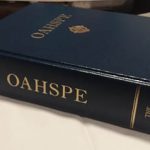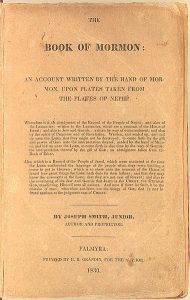
What does a “Mormon Faithist” look like?
In a submitted article “Various Sects of Faithists“, it was mentioned that among the different denominations adhering to certain points of Faithism, one is referred to as “Mormon Faithists.”
Some within the Latter Day Saint (Mormon) movement might be wondering, “What in the world is a Mormon Faithist?” In this brief article, we would like to highlight one of the sects mentioned in the article cited. Future articles will highlight other denominations.
Mormon Faithists are Both Christians and Oahspeans
Technically a “Mormon Faithist” is still a Christian like most Latter Day Saints, all be it, not of mainstream Christianity and probably only loosely affiliated with any major Mormon denomination. They hold the Old Testament, Apocrypha, and New Testament, along with the Book of Mormon and Oahspe Bible as their canonical text.
 Mormon Faithists explain that they look to the Bible (Old and New Testaments) and the Book of Mormon through the lens of the Oahspe. There are some Mormon Faithists who also accept the recently translated work, Sealed Book of Mormon. They usually refer to themselves as Nephites or Nephite Faithists. (More on Nephites below)
Mormon Faithists explain that they look to the Bible (Old and New Testaments) and the Book of Mormon through the lens of the Oahspe. There are some Mormon Faithists who also accept the recently translated work, Sealed Book of Mormon. They usually refer to themselves as Nephites or Nephite Faithists. (More on Nephites below)
Although these texts are what have become their standard Scriptures, their canon is not a closed one. They still rely on divine revelation, but this may vary from one degree to another among individuals.
Some Observances
The Mormon Faithists that we are familiar with, hold religious services in their homes on Saturday, believing that the seventh day of the week is to be set aside as a holy day, along with observing the new moons throughout the year.
Some people who consider themselves Mormon Faithists also believe in certain “ordinances” such as praying for the departed, baptism for the dead, and honoring the “Mother of God” (after the flesh) — all of which can be found in the Bible and the Book of Mormon. (See 2 Maccabees 12:46; 1 Corinthians 15:29; 1 Nephi 11:18, 1830 edition.) For those not familiar with these concepts, they need to be understood within their cultural and scriptural context. A comprehensive study on these topics goes beyond the scope of this article.
Some have equated polygamy with “Mormonism,” but only a small minority among certain extremist cults actually practice polygamy. Most people within the Latter Day Saint movement frown upon the practice and have forbidden it.
No “trademark on the Book of Mormon”
Henry Carr, a former member of the Church of Jesus Christ of Latter-day Saints, who now considers himself a Faithist, told us that “because the Utah LDS church is the largest so called Mormon denomination within the greater Latter Day Saint movement, people on the outside tend to think that the Utah headquarters produced the Book of Mormon and that all beliefs of the Utah based LDS are found in the Book of Mormon. This is far from the truth. Those who usually have a problem with the Book of Mormon are those who have never read it, and based their opinion of it on the opinions of others instead of investigating it themselves. The Utah church and some of its members have done a great disservice to the Book of Mormon and have turned many people away from the truths of Heavenly Father found within it. There is no Mormon denomination that has a trademark on the Book of Mormon. It belongs to anyone who believes that it serves as a testimony of previous sacred scriptures.”
“Around ten years ago, Deseret News published an article encouraging members of the Church of Jesus Christ of Latter-day Saints to read the Oahspe, saying it was ‘worth a look.’ Deseret News has many supporters among so called LDS Mormons. I know of some members of the LDS, Community of Christ and other Mormon sects who read the Oahspe on a regular basis.”
Did the Book of Mormon originate with a Drujan God?
In our interview with Brother Henry Carr, we asked how do Mormon Faithists reconcile the Book of Mormon and the Oahspe, especially since the Oahspe Bible clearly says that Mormons came from a drujan God.
In the Book of Es, Daughter of Jehovih Chapter XVIII, verses 7 and 8, we read:
A drujan God, Piad, established a sect, and named it, Mormon, and he located his kingdom on earth with his mortal followers, and he became master over the spirits of his mortal followers in the same way, calling himself, the TRUE KRISTE.
Piad taught, that all good Mormons would ultimately attain to rule over some planet and her heavens. But, he never permitted the angels of his kingdom to go out of his reach. He also taught mortals, that the more numerous progeny a man begot, the greater would be his heavenly kingdom, in time to come. For this was Piad’s scheme, to make his own heavenly kingdom large and powerful.
Carr said, “We believe this is in reference to a god that inspired Brigham Young, the founder of the Utah based LDS church, to split from the original Church of Christ which had been established by Joseph Smith, Jr. After Joseph’s death, Brigham Young convinced many of the members to follow him to Utah. While many followed him, Joseph’s wife Emma Smith, remained with the original church which was renamed ‘Reorganized Church of Jesus Christ of Latter Day Saints,” in Missouri, now known as Community of Christ. Joseph Smith III, Joseph’s oldest surviving son, became the president of the Reorganized church, sometimes called RLDS.”
“It’s actually very easy for us to reconcile those passages in the Oahspe. The Oahspe does not say that the drujan god wrote the Book of Mormon, but instead that it ‘established a sect, and named it, Mormon.’ It was Brigham Young that created an offshoot of the original Mormon church and brought about many changes, including doctrines that run contrary to the Book of Mormon. Eventually even the Book of Mormon was changed, and this is why the Mormon Faithists that I am aware of, use the 1830 edition, instead of the one copyright by Utah. There are other scriptures that Utah LDS Mormons use such as the book called Doctrine and Covenants and another called Pearl of Great Price. We don’t use either of those.”
Carr said, “Because the Utah based LDS church has gone so far from the truths of the Book of Mormon, some of us actually call ourselves Nephite Faithists — my family prefers that name instead of Mormon when identifying ourselves. The name Nephite comes from Nephi, an important character in the Book of Mormon, which all who read the Holy Book are aware. Calling ourselves Nephite instead of Mormon is closer to what we really are and helps avoid any misconstrued connections with the LDS sect. But there are still others who would rather call themselves Mormons.”
Similarities and Possibility of Brotherhood
 There are many striking similarities between the Book of Mormon and the Oahspe Bible. It is difficult to find too many doctrinal differences.
There are many striking similarities between the Book of Mormon and the Oahspe Bible. It is difficult to find too many doctrinal differences.
Because of the similarities and looking to the Oahspe as the filter in which Mormon Faithists (Nephite Faithists) look through to understand previously revealed scriptures, we should be willing to consider these individuals as our brothers and sisters, especially if we hold essential teachings in unity.
Mir Tazar, a Faithist elder and the author of the article “Various Sects of Faithists” said, “We see nothing barring fellowship between Mormon or Nephite Faithists, Essene Faithists and others who hold to the primary teachings of the Oahspe and to currently revealed texts. There are always differences in practices among groups and among individuals within the same group, but these practices, as long as they do not contradict the Oahspe Bible, should be considered minor, and not as a point of contention. Those who are not from a Mormon background would certainly not be required to read the Book of Mormon, but they would not be prohibited from it either. In a similar manner, Faithists who have texts unique to their background should not require or force such texts on Mormon Faithists. Otherwise, there would be unnecessary contention.”
“A united brotherhood of all Faithists who are in unison with one another in the essentials is encouraged, despite backgrounds or former affiliations. We must be willing to look beyond non-essential differences. Our purpose should be to come together to give all glory to Jehovih, and thus advance in knowledge and progress into the higher realms that the Creator opens to each human being depending on each ones advancement in living the virtues, helping others and coming to a proper knowledge of the All-Father’s purposes.”
(Editor’s note: It was very interesting communicating with Brother Henry Carr since both of us have a background with various LDS sects. We spent hours comparing notes. Naturally I was excited when he agreed to a future interview where I will be asking for his thoughts concerning the teachings in the Book of Mormon, the Sealed Book of Mormon and how he compares them to the Oahspe Bible.)
Nyle Dahlstrom, editor.